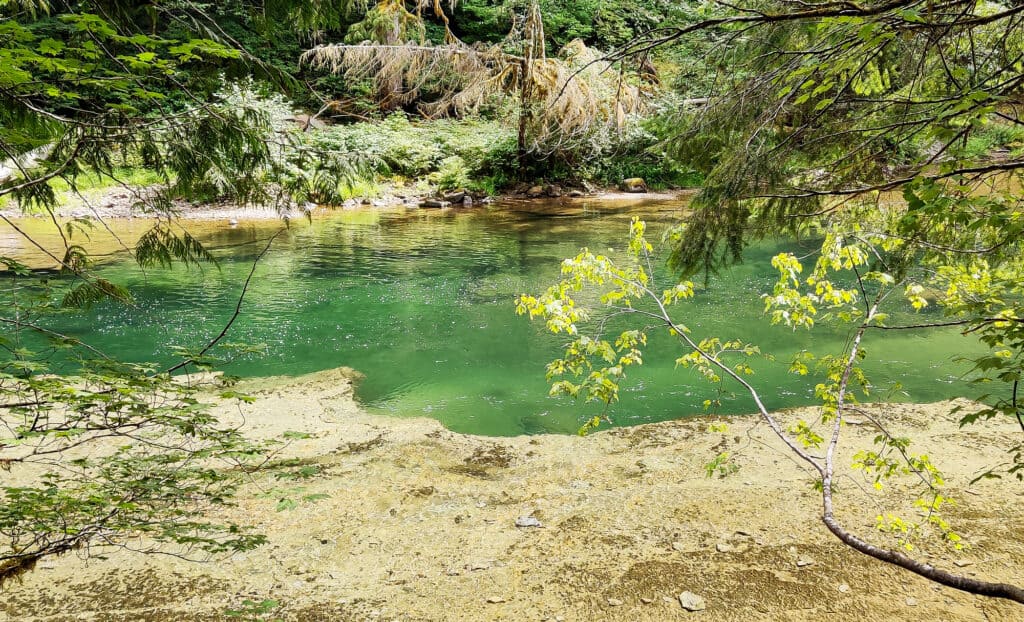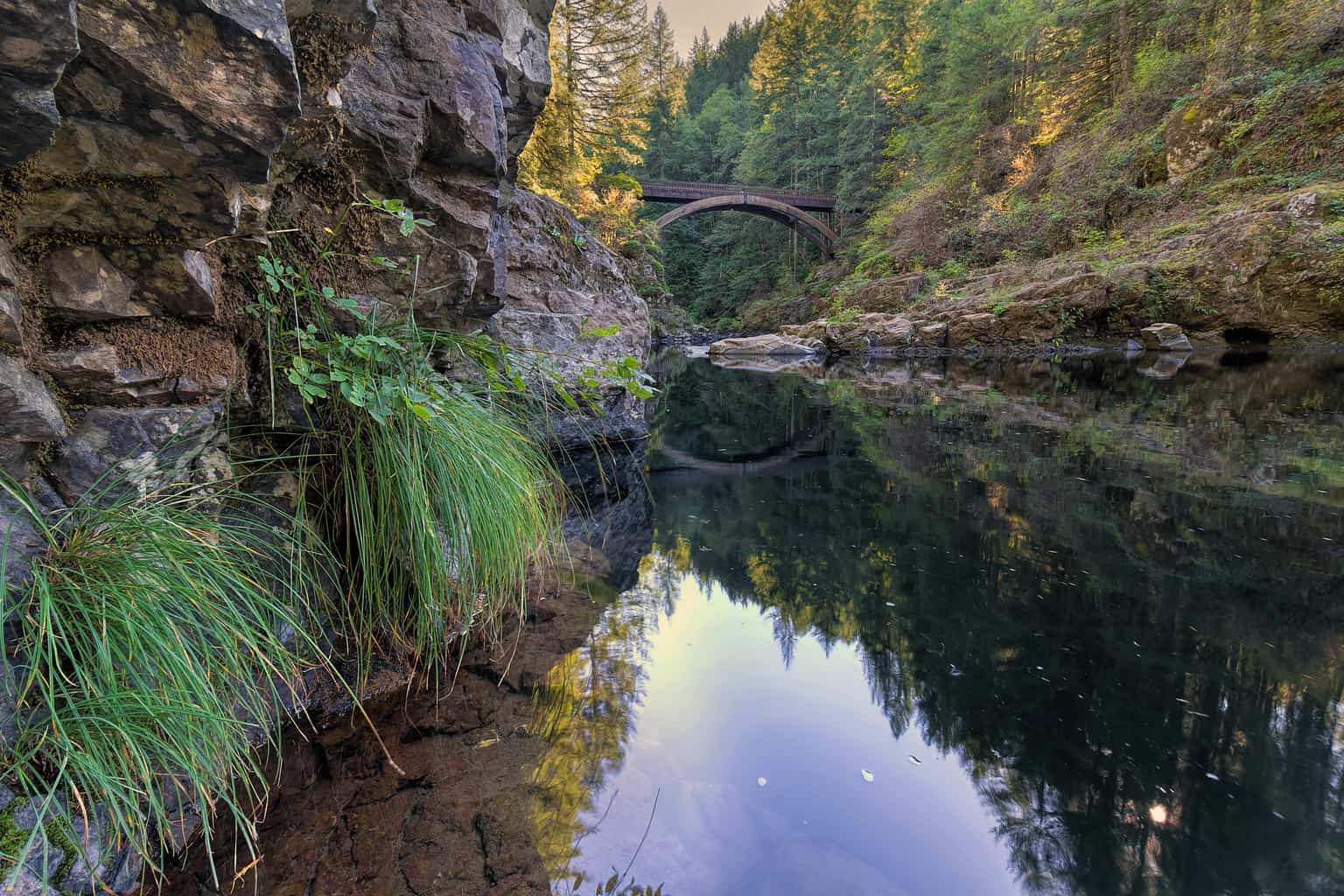Situated just north of the Oregon-Washington border, the Lewis River is one of the lower Columbia River’s most popular and productive tributaries.
The Lewis River is a long one, and it is dammed three times, creating three formidable reservoirs: Lake Merwin, Yale Lake and Swift Reservoir.
These reservoirs are essentially back-to-back, and there’s not much river in between. For the purposes of this article, we’ll be referring to the lower river (below Lake Merwin) and the upper river (above Swift Reservoir).
The mainstem Lewis, often called the North Fork Lewis, is popular with steelhead, salmon and trout fisherman alike. It’s also a pretty good fly fishing river.
Anglers, especially steelheaders, also commonly fish the East Fork in Clark County, which we’ll tackle after discussing the larger river.
Each stretch of the river offers different opportunities, and diverse riffles and runs lurk around every corner. If you’re looking for some reliable fishing action, the Lewis River is a great spot to go.
Let’s dive into the primary differences between the upper and the lower Lewis.
Fishing on the Lower Lewis River
By far the most popular stretch of the river, the lower Lewis River is home to often-plentiful runs of salmon and steelhead.
This is where you’ll see most of the angling pressure – the lower Lewis runs from Lake Merwin down to the mouth of the river near Woodland, a section of water stretching approximately 20 miles.
We’ll talk more about how to target the salmon and steelhead in the Lewis later on in the article, but know that if you’re thinking about salmon fishing, the lower Lewis is the place to be when runs are good.
This is a stretch of water that’s best fished by boat. Whether you’ve got your own or you book a guide, you’ll be a lot more successful on the lower river if you have a drift boat or raft so you can access the prime water.
Fishing on the Upper Lewis River

The upper Lewis is somewhat of an undiscovered gem. You may see another angler or two out on the water, but for the most part, it gets overlooked for the much more popular lower stretch.
However, the upper Lewis River is a great spot for fly fishermen in search of some classic, small-ish stream trout fishing.
Rainbow, cutthroat and bull trout all inhabit this portion of the river, but you may not target the protected bull trout and must release them unharmed if you catch them. Bull trout can grow to impressive sizes in the Northwest but their populations have suffered in many areas.
Fishing is catch-and-release for all wild rainbows and cutthroat as well, but there is a very short section of river (a mile or less) right above Swift and below the junction of Muddy River where you may retain hatchery rainbows, identified by a clipped and healed adipose fin.
These hatchery trout aren’t stocked in the river but are planted in Swift and may venture a short distance upstream.
As you head upstream, the Lewis gets smaller and smaller (and so do the fish).
It’s a fun experience for an adventurous fly fisherman, and while the upper Lewis isn’t nearly as popular as the lower stretches of the river, it’s still a great spot to check out.
Salmon Fishing
As we mentioned above, all of the salmon fishing action takes place on the lower 20 miles of the Lewis, where these migrating fish have access to the Columbia River down to the Pacific Ocean.
Chinook salmon make their way into the river in both the spring and the fall, while the coho run (like all other rivers in the PNW) occurs during the fall.
June is usually a peak for the spring Chinook run, while September and October are typically the most reliable for fall Chinook and coho.
Always check the latest regulations, though, because WDFW will close down salmon fishing the Lewis (as in other waters) if the returns are expected to be poor. But when runs are good, this is can be an excellent destination.
Both types of salmon are fun to catch, and the coho in the Lewis are known to grow quite large.
Catching these salmon is quite typical to most other rivers in the region.
The Lewis is best fished by boat, and bobber-and-roe tactics typically are king when it comes to fishing for Chinook, which often respond to bait.
Coho can be more aggressive at times than Chinook, particularly when they are freshly arrived in the river, and it’s a good idea to try swinging a few spoons or spinners through some of the swifter water.
As a general rule, coho hang out in water that’s faster and shallower than what Chinook prefer – this isn’t always true, but it’s a good rule of thumb to go by as you’re fishing the river.
Steelhead Fishing
Unlike salmon, steelhead hang around in rivers for a while after they spawn, and some steelhead end up returning back to the ocean. Due to this behavior, you can find steelhead in the Lewis River year-round.
The Lewis receives both summer and winter runs of steelhead.
The summer fish show up starting in May and June, with the run peaking sometime during July or August.
The winter fish, which are often bigger than the summer fish, show up in good numbers during December, with best fishing in December and January. Some winter fish hang around into late spring or early summer but their quality diminishes over time.
A bobber and jig is a great way to catch steelhead on the Lewis.
If a jig isn’t working out for you, try tipping the jig with a prawn – that can sometimes be the difference between getting skunked and catching a steelhead or two!
Both the steelhead and salmon seasons can change year-to-year, so be sure to keep up with the current regulations. The river is open nearly year-round, but not quite – so check before you get out fishing.
Trout Fishing
Bull trout, rainbow trout, whitefish, and cutthroat trout are all officially in the Lewis River. The most common catch will be rainbow and cutthroat trout, though you’ll see a bull trout or whitefish in the mix occasionally.
The majority of the trout fishing on the Lewis River is done above Swift Reservoir, and it’s most popular with fly fishermen and is primarily catch-and-release except in that area right above the reservoir where there might be a hatchery fish.
Conventional techniques such as spinners (and other artificial lures) are allowed and will catch fish as well.
If you’re fly fishing, try standard attractor nymphs.
There’s nothing particularly special about the bug life on the upper Lewis, and you won’t see a ton of prolific hatches.
Pheasant tails and hare’s ears are great patterns to try out.
If you’re euro nymphing, the standard patterns will work wonders: think perdigons, frenchies, and the like.
There isn’t a ton of dry fly activity to be had on the Lewis River, but if you’re itching for some dry fly eats, a size 14 stimulator is a good bet.
You might not catch the biggest fish, but there are eager rainbows and cutthroat in the river that aren’t very picky.
And, again, remember you can’t legally target the bull trout here and you must release them unharmed if you do catch bulls.
When to fish
The Lewis River offers spectacular fishing opportunities year-round. If you’re trying to figure out when to get out there, first decide what you want to fish for.
Want to try for some steelhead? Summer and late winter are great times to fish.
Salmon? Try spring and fall.
Or, if trout are what you’re interested in, the late spring and early fall are great times to fish.
Fortunately, winters don’t get brutal on the Lewis – because of its location, you’ll typically see mild winter weather, with temperatures in the 40s and rain being much more common than clear skies.
If you’re planning to head out to the Lewis in the winter, be sure to check river conditions before you do – the heavy rainfall can make the river high and unfishable quite frequently during the winter months.
Location and Access
The lower Lewis River is in a convenient location if you’re living near Portland or Vancouver. It’s just off of I-5 near Woodland, and makes for a great day trip if you’re not looking to drive very far.
The upper Lewis, however, is a slightly longer drive.
Once you get off I-5, you’ll make your way east on State Route 503 (and then Forest Road 90 farther upriver) until you get above Swift Reservoir, which can take a couple of hours if you’re coming from the Portland area.
There are numerous boat ramps on the lower Lewis River, and access isn’t much of a problem if you’ve got some sort of suitable watercraft like a drift boat.
On the upper river, though, you’ll be bank fishing. There are a few access points at bridges, and since the river is easily wadeable, you’ll be able to walk up and down to explore new water.
A couple of lightly used trails (likely made by anglers) run along the upper river as well, making it fairly easy to navigate. It’s not the spot to go if you don’t like a bit of hiking, but if you’re one for exploring, the upper Lewis is great.
Fishing the East Fork Lewis River
The east fork is the smaller of the two forks.
It headwaters in the Gifford Pinchot National Forest and generally flows south of the main Lewis, which it joins in the lower reaches near Interstate 5 after passing through Clark County.
Among anglers, the East Fork has been most famous for its steelhead runs, which years ago produced not only high numbers but some mammoth specimens. A state record winter steelhead caught here in the 1980s was nearly 33 pounds.
Unfortunately, the East Fork isn’t nearly the steelhead river it once was, although it still puts out both summer and winter fish produced in hatchery programs.
Runs throughout the region are cyclical, so an upswing of Northwest steelhead in general should mean better angling here as well.
There are river access points including Lewisville and Daybreak regional parks in the Battle Ground area, and you also can float from launches at Lewisville to Daybreak with a drift boat.
There are some additional boat access points farther downriver as well, but Lucia Falls and other drops are located upstream.
Trout and salmon fishing are highly regulated on the East Fork Lewis to protect sensitive fish species, so definitely give the regulations a careful reading and probably head to the North Lewis or other locations to catch those fish.
Conclusion
The Lewis River is a great option for some Washington fishing that’s not too far from Portland and Vancouver!
If you’re looking for some productive year-round fishing, this is a great river to check out. Tight lines.
Find more fishing spots in Clark County
Find more fishing spots in Cowlitz County
Washington Resources
WDFW Fishing and Stocking Reports
WDFW Fishing Regulations
National Weather Service forecasts
Carter Reschke is a freelance writer based in Oregon. Passionate about the outdoors, Carter is a fly fishing aficionado and spends his days on the river when he’s not writing.

